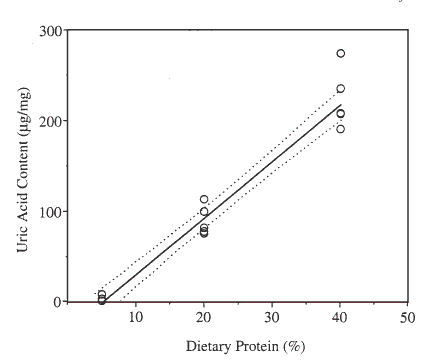I really enjoyed that article. I was able to find this graph in the study referenced about German cockroaches:
I think the link to the study is dead now, i wasn't able to follow the article to it, or i'm misremembering how i got there.
I wish I had a better understanding of what these numbers mean when compared to the UA levels of processing protein. Also, i'm not sure if UA ingested directly may be more problematic than UA broken down from protein. It is possible that some metabolic mechanism exist to in some way limit the digestion of additional protien, that would be ineffective against UA already free in the insect.
@xp29 did you have any luck finding the UA content of banded crickets? I'm unclear as to whether free UA is only present in roaches, or if it just present in larger amounts than other insects. I'd imagine
some amount of UA has to exist in a cricket that hasn't passed all the waste from the protein it digested yet, but is that half what is present in a Dubai? 10%? 1%? I have no idea, and that would be useful to know.
@Claudiusx around what protein level did you settle on? Or is it less a percentage, and more you just feed things you know are low in protein? I've been using Dubai Chow, or whatever dubai.com is calling thier roach food. I believe it is 17% protein. They reference that number in an
article on their site that initially pointed me to the repashy article.
They also claim they've seen no indications the incidents of Gout in Bearded Dragon's are increasing... They make no mention of how they went about looking for any such trend. And... unsurprisingly they don't think you need to worry much about feeding Dubai to your Dragon. In fairness they do recommend using a variety of feeders.
From the above linked article:
make sure to offer a wide variety of different feeder insects, alternating between high-protein feeders and lower-protein feeders.
If Claudiusx harping on the importance of variety in a Dragon's diet hasn't convinced someone yet. The fact that a website with Dubai
in the name is telling you not to feed only Dubai, ought to be a wake up call.
 www.store.repashy.com
www.store.repashy.com

